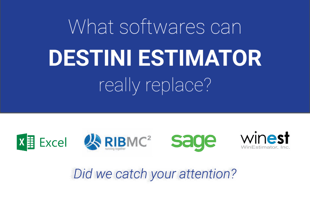How Disruptive Thinking in Preconstruction Can Help Your Business
“This is how we’ve always done it…”
We hear this a lot. And we sort of get it. Trying something new takes courage. You risk failing. But can you imagine if you applied this (ir)rational way of thinking to everything else in your life?
 Imagine what life would be like if we never embraced the disruptors of our past.
Imagine what life would be like if we never embraced the disruptors of our past.You’d still be shivering or sweating your way through your morning routine in an outhouse. To walk out there at night, you’d be carrying a kerosene lamp. Instead of checking on your kids via text, you’d be sending letters…the handwritten kind that requires stamps…that’d you’d have to harness the pony and hitch to the wagon and travel MILES to the nearest post office to mail. You’d be milking cows every morning, churning butter, and still getting up from the couch to switch channels on the TV.
Okay, so, yes, even though these are extreme examples, they don’t make the point less true. Obviously, just because something is the way it has always been, it doesn’t make it the right way.
Are you already beginning to feel uncomfortable?
Good. Because that is what disruptive thinking does. Disruptive thinking doesn’t just make you uncomfortable—it pretty much picks you up and shoves you out into the abyss of places you’ve never even dreamed of. And the best disruptive thinking brings you back more alive and lit up than you have ever been.
Disruptive thinking will shake you up. It will shake your company up. And quite possibly, it can and will shake up an entire industry.
What is Disruptive Thinking?
Disruptive thinking has been around since the dawn of mankind. We just hadn’t coined a term for it until fairly recently. The phrase was originally developed in 1995 by Clayton M. Christensen, a businessman, author, and academic who described it in business as “disruptive innovation,” defined as “…a process by which a product or service takes root initially in simple applications at the bottom of a market and then relentlessly moves up market, eventually displacing established competitors.” (Clayton Christensen)
However, we now use the terms “disruptive thinking” and “disruptive technology” interchangeably with disruptive innovation and have extended the definition to mean any different way of thinking that challenges what is traditionally done.
The wheel, roads, household appliances, electricity, the printing press, transmitters, vaccines, jet engines, the microprocessor, indoor plumbing, the internet…these are all disruptive technologies that stemmed from disruptive thinking.
Three of the most famous modern pioneers of disruptive thinking and technology are Steve Jobs, Elon Musk, and Jeff Bezos. Disruptive thinking gave us Apple, Amazon, Tesla, Netflix, Spotify, and all the other digital miracles we feel like we can’t live without. What if someone had told Jeff Bezos that going to the local bookstore was working just fine and there was no need to create an online shopping channel?
Sure, your way may work, but your way sure isn’t progressing and growing your business.
“You stop looking at outcomes and just make sure you’re doing the process right. Gulp. It’s not that rare to hear a junior leader defend a bad outcome with something like, “Well, we followed the process.”-Jeff Bezos
Let’s look at an example precon people will quickly understand—the differences between Design-Bid-Build and models like CM-at-Risk, Design-Build, and Integrated Project Delivery (IPD).
 Traditional Design-Bid-Build delivery models involve a high level of design documentation developed by the architect and engineers, largely in a vacuum without input from the contractor. Not until the lowest possible price is provided by several subcontractors who were invited to give bids is the cost truly known.
Traditional Design-Bid-Build delivery models involve a high level of design documentation developed by the architect and engineers, largely in a vacuum without input from the contractor. Not until the lowest possible price is provided by several subcontractors who were invited to give bids is the cost truly known.
This type of delivery model often delivers the lowest possible initial price but often results in lots of rework which drives the low bid higher than the owner originally anticipated. Also, this model has built a reputation for being "gamed" because bidders and contractors will knowingly overlook the missing scope that was identified early so that they can use it after the project is awarded to ask for more money. This request for additional funding for parts of a project that were unspecified or modified is known as a change order.
More modern delivery models, such as CM-at-Risk, Design-Build, and Integrated Project Delivery (IPD) have fostered collaboration and communication between the architect, engineer, and contractor with the intent on charging the entire team on delivering the best blend of design quality, cost, and schedule.
Those of you who have moved away from Design-Bid-Build know how much the new models:
- Increase communication and collaboration with project owners
- Better align stakeholders and contractors with the project’s plan
- Help keep the project on time and on budget
- Lead to a trusted relationship with owners
There’s been other innovations and disruptive thinking and technologies in precon, BIM being the major one. Though precon teams use BIM and 5D modeling, it certainly isn’t the norm with many teams still using Excel spreadsheets to build estimates or using outdated and unsupported software. Forward-thinking contractors like Sundt embrace new technology to impress clients and win projects. Sundt’s director of preconstruction services says, “The DESTINI product suite definitely helps us win projects. It’s definitely impressive. Clients receive a good visual and a price, just what our clients are looking for. They don’t want to spend time and money having an architect design something and then realize they can’t afford it. The DESTINI products give clients more confidence and insight as well as input in the preconstruction process. I like when clients are blown away.” (Sundt Talks About DESTINI Estimator)
Does this sound like something your company could use? Do you want to blow clients away and blow your competition out of the water?
Well, if so, you’ll need to start thinking disruptively.
How Can You Apply Disruptive Thinking in Preconstruction?
- Create the space—either physically, theoretically, or both for creative thinking.
Provide time for employees to brainstorm, share their thoughts, and offer new suggestions on ways to solve problems. Preconstruction estimators don’t just copy and paste data all day. They are problem solvers and critical thinkers. If your precon team is working in outdated and unsupported technologies, we guarantee they have thought about trying to find ways to make estimating more efficient. Disruptive thinking can start as simply as asking your team, “is there a better way we can do this?”
 “You can never cross the ocean until you have the courage to lose sight of the shore.” - André Gide (Photo courtesy of Johannes Plenio)
“You can never cross the ocean until you have the courage to lose sight of the shore.” - André Gide (Photo courtesy of Johannes Plenio)- Allow yourself to fail.
You’ll never know if something is going to work until you try. Experiment with testing new software specifically designed to streamline your workflows. Give your estimators room to explore more efficient ways of working. Along the way, you will learn lessons that lead to growth.
- Step out of your comfort zone.
Remember when we all had to text by going through the numbers on our phones? It was REVOLUTIONARY when the first keyboard phone was released. But even still, you learned how to text on a cell phone, right? All new technology requires a learning curve, but the time it takes to teach ourselves or be taught how to use a new program, tool, or device is incredibly worth the way tech has made a profoundly positive effect on our lives.
- Remember—Blockbuster turned down the opportunity to purchase Netflix. (Whoops.)
When asked, then Blockbuster CEO Jim Keyes said, “Neither RedBox nor Netflix are even on the radar screen in terms of competition.”
How to Step Out of Your Comfort Zone at Work
Would you rather have your team doing the bare minimum to get the job done or would you prefer your team to go above and beyond to produce exceptional work?
We’re guessing it’s the latter. Though it is understandable why you’ve gotten stuck there—it avoids risk and it works, you cannot progress and grow if you stay in your comfort zone.
4 Tips to Moving Out of Your Comfort Zone
- Take baby steps. Like downloading a free trial or request a demo of new and innovative software, like DESTINI Estimator.
- Share fresh ideas and open up communication and collaboration by holding virtual roundtable discussions with your precon teams dispersed through many different offices.
- Make precon meetings a regular event where your team sits down with the owner before starting estimates.
- The last but most important tip is to keep an open mind. Allow yourself to recognize your reluctance to change and then just take the leap!
Disruptive thinking has transformed our lives and upended entire industries for the better. The successful disruptive thought leaders, the companies that supported these disruptive thinkers and the disruptive technology they’ve developed have all added value to our lives and left their competitors scrambling to keep up or worse…left bankrupt.

-1.png?width=112&height=112&name=image%20(4)-1.png)















